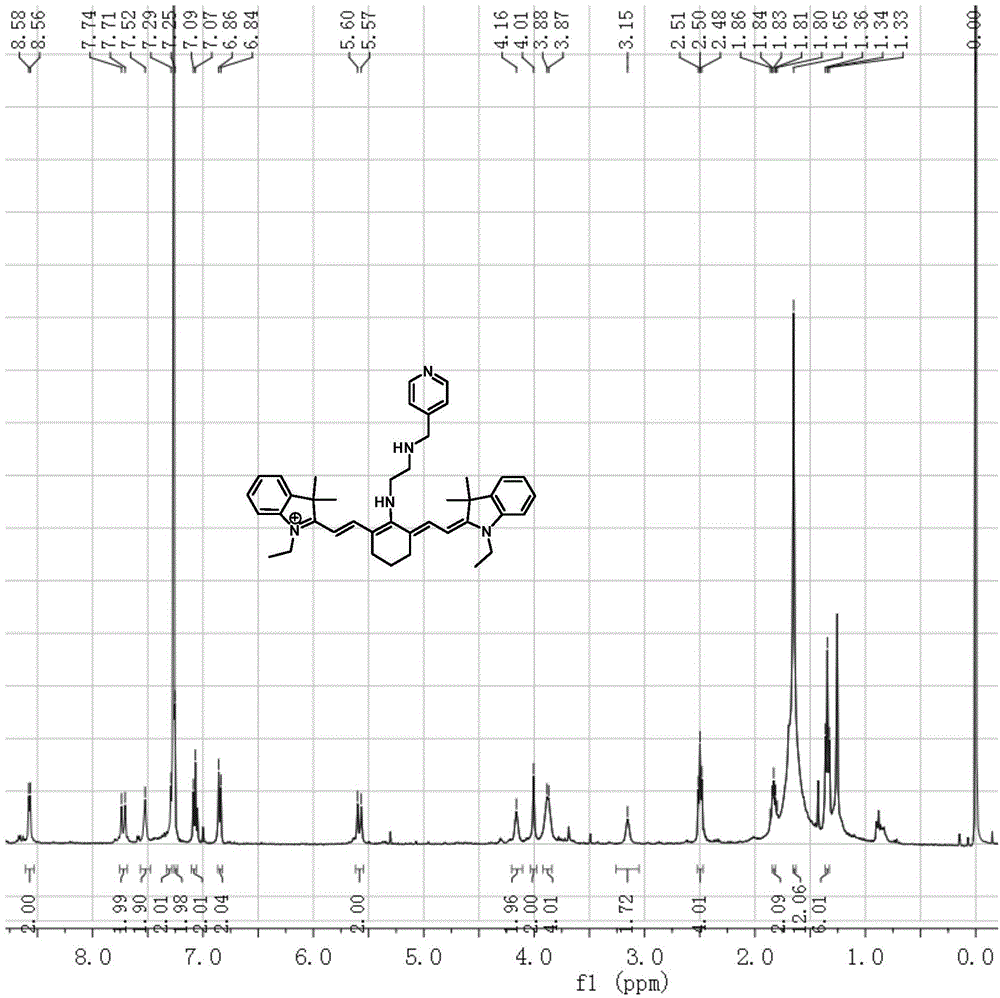Restoring-type near infrared fluorescence probe with pH response and preparation method and application thereof
A fluorescent probe and near-infrared technology, applied in the field of bioluminescent analysis, can solve the problems of difficult tumor detection, short pH probe wavelength, high signal-to-noise ratio, etc., and achieve simple and easy-to-operate preparation methods and less damage to cells and living bodies , the effect of low signal-to-noise ratio
- Summary
- Abstract
- Description
- Claims
- Application Information
AI Technical Summary
Problems solved by technology
Method used
Image
Examples
Embodiment 1
[0065] A preparation method of a recovery type near-infrared fluorescent probe with pH response, comprising the following steps:
[0066] (1) The preparation chemical formula is The switch numerator:
[0067] Dissolve 2.6696mL of ethylenediamine in 10mL of methanol, add it to a 50mL two-necked flask, stir rapidly under ice-bath conditions and dissolve 844.3μL of 4-formaldehyde pyridine in 10mL of methanol and add it dropwise to the above solution, at 0°C N 2 Protection reaction 1h.
[0068] Then, 0.57 g of sodium borohydride was added in batches to the two-necked flask, reacted for 2 h, and 10 mL of distilled water was added and stirred for 20 min to terminate the reaction. Use a rotary evaporator to spin off the solvent, and dry in vacuo for 24 hours. Then add 20mL of distilled water, extract three times with 50mL of dichloromethane, collect the organic phase, spin off the solvent, pass through the column with basic alumina, and use the volume ratio of dichloromethane an...
Embodiment 2
[0075] A preparation method of a recovery type near-infrared fluorescent probe with pH response, comprising the following steps:
[0076] (1) The preparation chemical formula is The switch numerator:
[0077] Dissolve 2.6696mL of ethylenediamine in 10mL of methanol, add it to a 50mL two-necked flask, stir rapidly under ice bath conditions and dissolve 844.3μL of 4-formaldehyde pyridine in 10mL of methanol, and add it dropwise to the above solution. 2 Protection reaction 1h.
[0078] Then, 0.57 g of sodium borohydride was added in batches to the two-necked flask, reacted for 2 h, and 10 mL of distilled water was added and stirred for 20 min to terminate the reaction. Use a rotary evaporator to spin off the solvent, and dry in vacuo for 24 hours. Then add 20mL of distilled water, extract three times with 50mL of dichloromethane, collect the organic phase, spin off the solvent, pass through the column with basic alumina, and use the volume ratio of dichloromethane and methano...
Embodiment 3
[0082] A preparation method of a recovery type near-infrared fluorescent probe with pH response, comprising the following steps:
[0083] (1) The preparation chemical formula is The switch numerator:
[0084] Dissolve 1.3348mL of ethylenediamine in 10mL of methanol, add it to a 50mL two-necked flask, stir rapidly under ice-bath conditions and dissolve 422.15μL of 4-formaldehyde pyridine in 10mL of methanol and add it dropwise to the above solution. 2 Protection reaction 1h.
[0085] Then, 0.29 g of sodium borohydride was added in batches to the two-necked flask, reacted for 2 h, and 10 mL of distilled water was added and stirred for 20 min to terminate the reaction. Use a rotary evaporator to spin off the solvent, and dry in vacuo for 24 hours. Then add 20mL of distilled water, extract three times with 50mL of dichloromethane, collect the organic phase, spin off the solvent, pass through the column with basic alumina, and use the volume ratio of dichloromethane and methano...
PUM
| Property | Measurement | Unit |
|---|---|---|
| Concentration | aaaaa | aaaaa |
Abstract
Description
Claims
Application Information
 Login to View More
Login to View More - R&D Engineer
- R&D Manager
- IP Professional
- Industry Leading Data Capabilities
- Powerful AI technology
- Patent DNA Extraction
Browse by: Latest US Patents, China's latest patents, Technical Efficacy Thesaurus, Application Domain, Technology Topic, Popular Technical Reports.
© 2024 PatSnap. All rights reserved.Legal|Privacy policy|Modern Slavery Act Transparency Statement|Sitemap|About US| Contact US: help@patsnap.com










